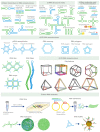Biomolecule-Based Optical Metamaterials: Design and Applications
- PMID: 36354471
- PMCID: PMC9688573
- DOI: 10.3390/bios12110962
Biomolecule-Based Optical Metamaterials: Design and Applications
Abstract
Metamaterials are broadly defined as artificial, electromagnetically homogeneous structures that exhibit unusual physical properties that are not present in nature. They possess extraordinary capabilities to bend electromagnetic waves. Their size, shape and composition can be engineered to modify their characteristics, such as iridescence, color shift, absorbance at different wavelengths, etc., and harness them as biosensors. Metamaterial construction from biological sources such as carbohydrates, proteins and nucleic acids represents a low-cost alternative, rendering high quantities and yields. In addition, the malleability of these biomaterials makes it possible to fabricate an endless number of structured materials such as composited nanoparticles, biofilms, nanofibers, quantum dots, and many others, with very specific, invaluable and tremendously useful optical characteristics. The intrinsic characteristics observed in biomaterials make them suitable for biomedical applications. This review addresses the optical characteristics of metamaterials obtained from the major macromolecules found in nature: carbohydrates, proteins and DNA, highlighting their biosensor field use, and pointing out their physical properties and production paths.
Keywords: biomolecule-based metamaterials; crystals; hydrogel; lattices; nanoparticles; nanostructure.
Conflict of interest statement
The authors declare no conflict of interest.
Figures







Similar articles
-
Recent advances in the metamaterial and metasurface-based biosensor in the gigahertz, terahertz, and optical frequency domains.Heliyon. 2024 Jun 21;10(13):e33272. doi: 10.1016/j.heliyon.2024.e33272. eCollection 2024 Jul 15. Heliyon. 2024. PMID: 39040247 Free PMC article. Review.
-
Metadevices with Potential Practical Applications.Molecules. 2019 Jul 22;24(14):2651. doi: 10.3390/molecules24142651. Molecules. 2019. PMID: 31336634 Free PMC article. Review.
-
Blueprints of Architected Materials: A Guide to Metamaterial Design for Tissue Engineering.Adv Mater. 2024 Nov;36(47):e2408082. doi: 10.1002/adma.202408082. Epub 2024 Oct 6. Adv Mater. 2024. PMID: 39370588 Free PMC article. Review.
-
Plasmonic Metamaterials for Nanochemistry and Sensing.Acc Chem Res. 2019 Nov 19;52(11):3018-3028. doi: 10.1021/acs.accounts.9b00325. Epub 2019 Nov 4. Acc Chem Res. 2019. PMID: 31680511
-
A mechanical metamaterial made from a DNA hydrogel.Nat Nanotechnol. 2012 Dec;7(12):816-20. doi: 10.1038/nnano.2012.211. Epub 2012 Dec 2. Nat Nanotechnol. 2012. PMID: 23202472
Cited by
-
Neural network properties of hydrophilic polymers as a key for development of the general theory of evolution.R Soc Open Sci. 2025 Apr 23;12(4):242149. doi: 10.1098/rsos.242149. eCollection 2025 Apr. R Soc Open Sci. 2025. PMID: 40271142 Free PMC article. Review.
-
Exploring the potential and safety of quantum dots in allergy diagnostics.Microsyst Nanoeng. 2023 Nov 17;9:145. doi: 10.1038/s41378-023-00608-x. eCollection 2023. Microsyst Nanoeng. 2023. PMID: 38025887 Free PMC article. Review.
-
Prerequisites for Developing a Classification of Phase Transitions in Systems Based on Thermosensitive Polymers: Use of a Semi-Empirical Model.Polymers (Basel). 2025 May 22;17(11):1441. doi: 10.3390/polym17111441. Polymers (Basel). 2025. PMID: 40508684 Free PMC article.
References
-
- Higgins S.G., Becce M., Belessiotis-Richards A., Seong H., Sero J.E., Stevens M.M. High-Aspect-Ratio Nanostructured Surfaces as Biological Metamaterials. [(accessed on 29 September 2022)];Adv. Mater. 2020 32:1903862. doi: 10.1002/adma.201903862. Available online: https://onlinelibrary.wiley.com/doi/pdf/10.1002/adma.201903862. - DOI - DOI - PMC - PubMed
-
- Liang L., Fu Y., Li L., Zheng H., Wei X., Wei Y., Kobayashi N. RNA-CTMA dielectrics in organic field effect transistor memory. Appl. Sci. 2018;8:887. doi: 10.3390/app8060887. - DOI
Publication types
MeSH terms
Substances
LinkOut - more resources
Full Text Sources

